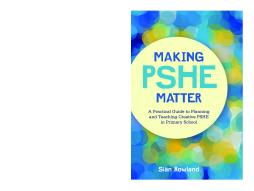
Additional Information
Book Details
Abstract
Offering ideas for different ways to teach PSHE, this is a go-to resource for the busy teacher looking for creative and engaging techniques. It provides tips, case studies and strategies on planning and pitching sessions as well as weaving PSHE into other aspects of the curriculum.
The practical advice includes tips for what works with pupils, ideas for group games, ways to make discussions more engaging and proven techniques for creating inspiring sessions. The book explores a range of complex PSHE topics such as social media, sex and sexuality, mental health and British values. This tried-and-tested guidance will help to give teachers the confidence to create accessible and dynamic skills-based sessions which can make a real difference to pupils.
Siân Rowland is an independent PSHE adviser, trainer and writer. She was previously a primary deputy head and has written education resources including award winning resources for The Co-operative, John Lewis, Nuffield Health, Living Streets, the PSHE Association and the Foreign and Commonwealth Office. http://www.sianrowland.co.uk/
Sian Rowland has written a comprehensive, practical guide to teaching PSHE with passion & heart. Whether you are a teacher of PSHE or responsible for whole school provision, read this book - and learn from one of the best.
Mal Krishnasamy, Director of MalCPD Education Consultancy & Coaching
If you want to renew your approach to PSHE then look no further. This thought provoking text offers really rich support for professionals who want to creatively involve young people in the PSHE curriculum. Case studies , planning guidance and practical ideas abound, framed by a close consideration of underpinning principles which will enable practitioners to tailor their PSHE teaching to their learners. An accessible and engaging read.
Professor Teresa Cremin, The Open University
From how to approaches for policy and planning, to meaningful engagement with children, their families and governors, this book is one of our go to books that we'll recommend to primary schools to deliver PSHE that's fit for purpose. It's bursting with examples, ideas and real world case studies, to help you forge authentic partnerships between school, children and home.
Lizzie Jordan, CEO & Founder Think2Speak
Table of Contents
| Section Title | Page | Action | Price |
|---|---|---|---|
| Making PSHE Matter: A Practical Guide to Planning and Teaching Creative PSHE in Primary School by Siân Rowland | 3 | ||
| Introduction | 7 | ||
| 1. Looking at the Bigger Picture | 9 | ||
| Understanding PSHE | 9 | ||
| Delving into history | 12 | ||
| Getting to grips with guidance | 17 | ||
| Linking SMSC and PSHE | 20 | ||
| Approaching difference and diversity in PSHE | 27 | ||
| Thinking about values | 35 | ||
| 2. Planning Your School’s PSHE Programme | 39 | ||
| Building a spiral curriculum | 39 | ||
| Understanding what children need | 42 | ||
| Creating a policy | 44 | ||
| Starting points for PSHE | 49 | ||
| Programming PSHE into a busy curriculum | 55 | ||
| Creating cross-curricular links | 59 | ||
| Threading key skills through your programme | 64 | ||
| Building a PSHE lesson from the ground up | 73 | ||
| Using resources and schemes of work | 78 | ||
| 3. Teaching and Learning in PSHE | 83 | ||
| Teaching and learning in PSHE: what works and what doesn’t | 83 | ||
| Creating a triangle of knowledge, skills and understanding | 87 | ||
| Covering key topics in PSHE | 91 | ||
| Teaching relationships and sex education | 93 | ||
| Teaching about drugs and alcohol | 107 | ||
| Teaching about change, loss and bereavement | 113 | ||
| Living in the wider world – economic wellbeing and being a responsible citizen | 119 | ||
| Thinking about mental health | 123 | ||
| Learning to be happy? | 126 | ||
| Answering tricky questions | 129 | ||
| Linking PSHE and Science | 133 | ||
| Responding to national and international incidents | 138 | ||
| 4. Making PSHE Outstanding | 141 | ||
| Building outstanding lessons | 141 | ||
| Setting ground rules | 142 | ||
| Creating the ground rules | 144 | ||
| Safeguarding and confidentiality in PSHE | 146 | ||
| Creating distance | 147 | ||
| Introducing a topic | 148 | ||
| Using discussion techniques | 149 | ||
| Using drama techniques | 155 | ||
| Using more familiar techniques | 159 | ||
| Ending well | 162 | ||
| Introducing assessment | 162 | ||
| 5. Beyond the PSHE Curriculum | 173 | ||
| Thinking about circle time | 173 | ||
| Encouraging pupil voice | 175 | ||
| Making visits and inviting visitors | 176 | ||
| Planning a theme day or week | 182 | ||
| Thinking about staff wellbeing | 187 | ||
| 6. Taking the Next Steps | 193 | ||
| Creating an action plan for PSHE | 194 | ||
| Ten Principles of PSHE Education | 199 | ||
| Blank Page |
